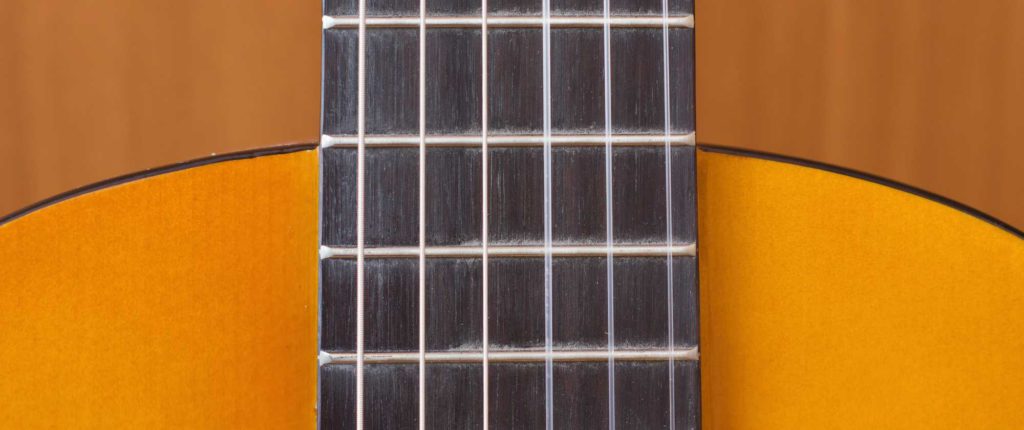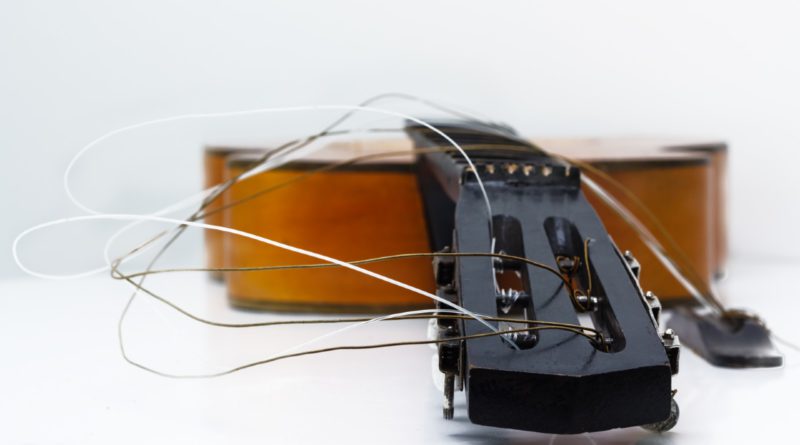Steel and nylon guitar strings are not interchangeable. While you could experiment with them and make them work, it will take a toll on your guitar neck. Such a decision can be justified by creative aspirations if you are either willing to use a dedicated ‘nylon-strung acoustic guitar’ and are prepared to put in the work to maintain it.
From the jaw-dropping Metallica covers of Rodrigo y Gabriela to the soulful indie-folk of Christopher Paul Stelling, the “classical” guitar strung nylon strings are not bound to any one genre of music. It has been used in tangos, fingerstyle pop arrangements, blues, jazz, and by country virtuosos like Buster Jones (more country stuff here).
So can you put nylon strings on a steel-string acoustic guitar?
Yes, you can put nylon strings on a steel-string acoustic guitar, but you will run into a number of issues, from tuning stability, to tension issues, to the lack of a ball end.
Nylon and steel strings may not be as divergent as night and day, but they are sufficiently distinct. In this article, we’ll highlight the form and function of steel vs. nylon guitar strings and how these variances make them less than ideal as substitutes for each other.
Contents
Nylon Strings on Steel-string Acoustic: Good or Bad?
Inspired by the artists such as José González, Willie Nelson, or Earl Klugh, at some point, we all contemplate the idea of swapping steel-strings with nylon strings on our acoustic guitar. The more maverick of us will even dare envisage them on an electric.
Nevertheless, when it comes to musical application, steel strings and nylon strings ‘march to a different drummer’. Let us take a brief look at each type before we discuss the common issues with trying to use one instead of the other.
Steel Strings for Guitar: An Overview
“Steel strings” is an umbrella term to describe acoustic guitar strings (read our full guitar string guide). They are made from varying alloys of bronze, phosphor, and sometimes aluminum. The ratio of the materials used in the alloy plays a vital role in the crispness and tonal character of the sound produced.
Phosphor-Bronze versions are warm, airy, and preferred for fingerpicking. They sound dark but also have the brilliance found in other types of strings. Bronze strings (80% copper + 10% tin) are bright, but they wear out fast because bronze tends to oxidize.
Nylon Strings for Guitar: An Overview

Nylon strings emerged as a cheaper and more durable alternative to the traditional gut strings. They have lower tension and a soft, warm tone with less clarity compared to steel strings. Unlike other string-types, nylon gauges are indicated as hard, medium-hard, and extra hard.
Like steel strings, nylon strings are available in a wide range of options based on the material, gauge, core, and composition. Though rare, you can also find Carbon or Fluorocarbon strings such as the D’addario EJ45FF ProArte Carbon that approximate the tone of gut or nylon strings.
From Pat Metheny to George Harrison to Lauryn Hill, the nylon string guitar has been used by many artists in popular records. Even artists like Metallica, Van Halen, and Tom Morello (the kind you’d least expect) have used it in songs and live performances.
Yet, these musicians are using traditional classical guitars with nylon strings. Many musicians miss the fact that the guitar solo in “Don’t Speak” (No Doubt) was played on a nylon string guitar in the original record, not on a steel-string acoustic with the strings swapped.
The Risks and Dangers of using Nylon Strings on Steel Guitars
#1 Nylon String tuning is less steady
Even on nylon string guitars (classical), the strings need to be tuned often, as they are sensitive. The soft nylon is susceptible to humidity and temperature changes and can go out of tune a lot more than the steel equivalent. Steel strings only go out of tune when they are new and are relatively more stable once they are adjusted and settled in.
#2 Neck tension varies
The biggest drawback of using nylon strings on a steel-string guitar is the damage it can do to the neck because of the lack of tension. Even if you use a mix of steel and nylon strings, for example, three steel and three nylon, you will create uneven neck-tension. Steel strings need to be wound tighter to tune them. Nylon stings are relatively loose and floppy.
#3 You can’t use guitar picks for strumming
Nylon strings aren’t made to be strummed with a guitar pick, as evidenced by the lack of a pickguard in classical guitars. Since they are primarily for classical guitars, they are popular for fingerpicking, often with long nails or (fake nails). Moreover, guitar picks will wear our nylon strings a lot fast. You can learn some classical guitar strumming techniques to strum chords, although it will sound very different.
#4 Restringing issues while interchanging strings
If you’ve noticed, the steel-string acoustic guitar strings have a ball-end that is inserted into the bridge and kept in place with a peg. Nylon string guitars have a plain end instead of a ball end. In a classical guitar, the bridge is made with holes where you insert the plain end and tie the strings to the bridge with a knot. This makes restringing an acoustic with nylon strings impossible.
Some important tips to use nylon strings on a steel-string acoustic:
As we said, it is uncommon to use nylon strings on a steel-string acoustic. Obviously, many have defied the norm, and so could you. It was common to see nylon strings on steel-string guitars during the urban folk revival of the 50s and 60s. Heck, you could also see them used on folk instruments like banjos.
However, most of these songwriters and folk artists played fingerstyle tunes, often in open or alternate tunings. You can swap strings if it is warranted by your creative pursuit. Just bear in mind that will expose your instrument to the aforementioned risks.
Additionally, keep a dedicated, cheap steel-string guitar that is solely strung with nylon strings. This ensures that you don’t keep switching strings and mess up the neck with varying tension.
Secondly, if you want to string your steel-string guitar with nylon strings, you need to find special ball-end nylon strings like the Martin Classical M260 or Ernie Ball Ernesto Palla Nylon Black. They are a bit harder to find in stores, but you will get a decent set online as there are quite a few guitarists who use them to string their steel-string acoustic guitar.
Lastly, if you’ve got the dough, consider buying a custom-made instrument or a crossover guitar. Crossover guitars are specially designed hybrids that merge the delights of a steel-string acoustic with a nylon-string classical guitar. A good example of this would be Daniel Zucali’s Crossover Acoustic Guitar.
Related Questions: Nylon and Steel Strings FAQ
Is it easier to play guitar with nylon strings?
Nylon strings have lower tension and are softer compared to steel strings. This means they are less likely to cause pain or leave an impression on your fingers, especially if you are a beginner. Most guitarists will develop callouses on their fingertips with practice, which negates this advantage.
What is better nylon or steel guitar strings?
Steel guitar strings have a characteristic brightness and crisp tone that cut the mix with better projection and overall volume. Nylon strings, due to their softer material, have a light attack, less sustain, and a plush sweeping sound across the mids. They lack the glimmer in the highs and the thump in the low-end.
Can you string a nylon or classical guitar with steel strings?
No, nylon guitars are not designed for the additional tension of steel strings. Steel strings have substantially higher (100 lbs more) string-load tension and will stress the neck. And, nylon guitars usually don’t even have a truss rod (if you don’t know what a guitar truss rod is, read our guide).
Moreover, nylon body tops are generally made from softer woods like Cedar with a thinner sounding board (top) and different (more delicate) bracing compared to the steel-string guitars, which have more rigid tops and heavy-duty bracing. You might get away with stringing a steel-string guitar with nylon strings, but vice versa will be a lot less forgiving.
Final Thoughts
Strings are a relatively inexpensive way to experiment with your playing style and tone. While nylon strings offer a wide range of options that can utterly change the character of an acoustic, you will have to make some amendments to your playing technique and style to compensate for their lower tension.
We hope this article has outlined all the aspects of using nylon strings on a regular steel-string guitar. You can follow our tips and try it on an entry-level or mid-market instrument. On an expensive instrument, however, we’d advise against it.

